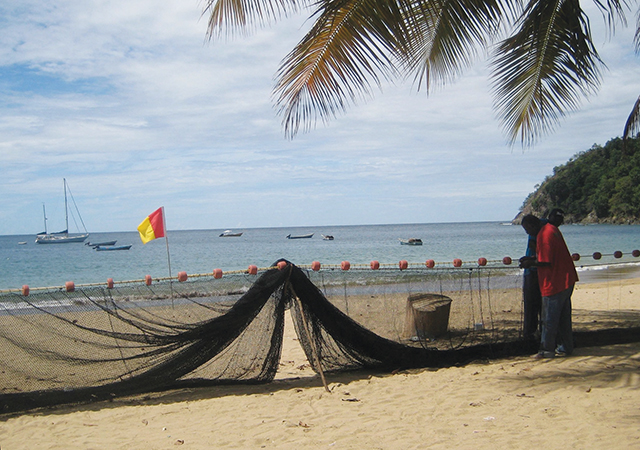Clean, green and serene, indeed (published June 2012)
I live on board Discovery V, a Bowman 57-foot cutter-rigged ketch, with my husband, Kirk, and 12-year-old twins, Wesley and Claire. We sailed from Toronto and spent 2010’s hurricane season in Trinidad, working on boat projects, enjoying time with friends, and getting to know the many facets of Trinidad. On October 14, 2010, we set sail on a 90 nm passage to Tobago, managing to finally break away from Trinidad’s rather magnetic pull. We had given into temptation more than once to stay “just a few more days” and strike additional items off the list.
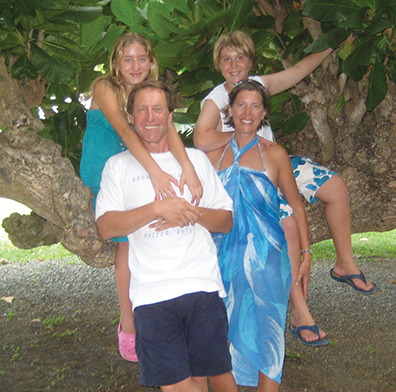
After seemingly endless conversations with other sailors debating the best route to take and the timing of the tides and currents, Kirk and I slipped our mooring lines at 4am with the kids sound asleep. The sleek, dark shapes of dolphins kept me company at my position on the bow, looking out for unlit ships as we navigated through the commercial boat traffic of Chaguaramas. Our dolphin escort saw us safely into the Boca, and by 6am we were through the swirling waters and turning to follow Trinidad’s rugged north coast. As the sun rose, the squalls hit and I figured it was a good time to go back to bed, leaving Captain Kirk up to weather the storms.
By mid-morning, the squalls were lessening as we continued east along the shore as far as Grand Riviere, then turned north to travel the remaining 24 miles to Tobago. We had learned of the strong west-setting current running in this area and had to adjust our course many times to compensate for our westward drift. About 12 miles from Tobago, we left the rain behind and motor-sailed on a close reach into Store Bay, setting anchor in time to enjoy a beautiful sunset with the dark hills of Trinidad on the horizon.
SWELLS, SNACKETTES & “SUNDAY SCHOOL”
Swells tend to curve around into the bays of this island, as Tobago has no defined leeward or windward shore. After the flat seas of our anchorage in Trinidad at the TTSA, it took a day to adjust to the slight rocking motion of the boat again. The Store Bay anchorage was quite comfortable during the week we spent there, but we did hear many tales of what northerly swells can do. The only swells bothering us were from the active group of jet skis and a couple of glass-bottom boats going back and forth to the Buccoo Reef.
Our dear friends Jan and David on board Mistral call Tobago home for a few months a year and were waiting to show us around one of their favorite islands. Store Bay, at the south end of the island, features spectacular white sandy beaches lined with palm trees and a few posh resorts. There is no dinghy dock, so be prepared to haul up on the beach and lock to a tree, or anchor and swim to shore. At the south end of the bay (near the airport) is a lovely, clean public beach and park with vendors selling local food, souvenirs, homemade soursop ice cream and cold beer. A huge, umbrella-shaped almond tree provides shade from the sun and shelter from the showers. A short walk through the park toward the airport brings you to the roti and doubles stands. At the north end of the bay is the Pigeon Point Heritage Park and beach, with an entry fee that is waived if you are going to patronize one of the bars, restaurants or gift shops.
The morning after arrival, we were off to the big city of Scarborough on the other side of the island to check in with Customs and Immigration. Scarborough has a fun marketplace vibe with many street vendors selling everything from sweets to ladies’ lingerie. David came along to show us how to identify the route taxis (cars will flash lights or honk as they approach) to get to Scarborough and points in between (for TT$6 or less, about US$1) and give us a hand with checking in. Almost directly across the street from Immigration was a bar selling three beers for TT$25 (about US$4). Given Kirk’s hydration philosophy, we managed to go through several rounds (it was 5 o’clock somewhere) while Claire and Wesley happily shopped for the latest pirated movies at a stand down the street.
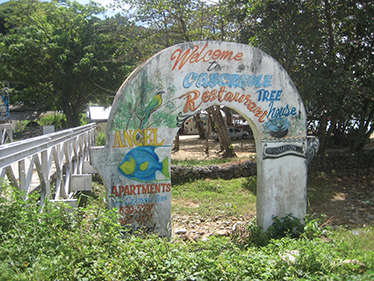
The delicious aroma of the soup at the table beside us stirred our appetites and soon we were lunching on “cow heel” soup from the adjacent snackette. This flavorful soup is considered “man food” and we had lots of fun with the men in the bar discussing the merits of the soup and the qualities it is rumored to imbue. Perhaps what they said was true, as two ladies at the table behind me were unabashedly making eyes at my husband. One even brazenly asked if I could move my chair a bit as I was obstructing her view! Seeing that we shared impeccable taste in men, Hilda, Hattie and I made plans to meet up that Sunday night at “Sunday School” (a local jump-up with steel band music) for some dancing and limin’. I made a mental note not to leave my husband unattended!
At Bago’s Beach Bar, located on the smaller beach at Store Bay (laundry/Internet café next door), we met an interesting assortment of friendly locals and within a few days had gathered a larger group to join us for Sunday School, which lived up to its reputation as a great party. We took route taxis up into the small village of Buccoo, where the festivities take place along a stretch of road about a half-mile long, lined with a handful of bars and restaurants. The fabulous 20-member steel drum band began to play everything from Rihanna to Mozart around 9pm and didn’t stop until almost midnight. There were stalls and tents set up selling food and artwork, and some for gambling. More people filtered onto the street as the night progressed, and by midnight several hundred were in attendance. The DJ kicked in when the band finished and the dancing continued. Shortly after midnight, a truckload of Tobago’s finest soldiers showed up to check out the crowd and make sure all was peaceful—and it was.
STUFFED TO THE GILLS
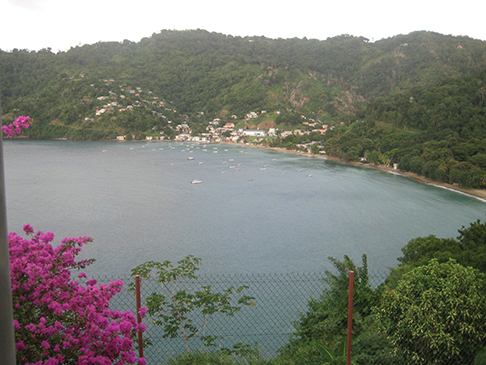
There are many fine snorkeling and dive sites in Tobago. Jan and David took us to their favorite spot on the Buccoo Reef and were distressed at the bleaching of the coral that had occurred in the few short months since they had last been there. The coral was white and the fish scarce. Later, Jan showed us their underwater photos of that same spot taken in June, and the change was startling. We heard that pollution and a rise in water temperature might be to blame, but no one seemed to have a clear explanation. Charlotteville proved to have some of the best snorkeling we experienced in Tobago.
A 20-minute taxi ride up into the hills towards the Mount Irvine Hotel will bring you to the Kimme Sculpture Museum (luisekimme.com). Luise Kimme carves and paints beautiful, larger-than-life-sized people and creatures from tree trunks and large pieces of wood. Her carvings are beautiful and it feels as if you are mingling with a crowd of majestic beings. She welcomes people into her home to view her art and visit with her on Sundays from 10am to 2pm for a small fee. Luise is also a dog lover and often takes in strays. The half dozen or so dogs living with her at the time of our visit basked in the attention from my kids, and Luise sent us on our way with okra and fresh herbs from her garden.
After a week in Store Bay, we pulled up anchor and sailed to the charming little fishing village of Castara. Tobago’s slogan, “Clean, Green and Serene” is exemplified here as you watch the fishermen leisurely mending their nets on the long sandy beach dotted with colorfully painted buildings. Castara must be home to some talented artists, as even the shop signs are works of art. A short walk across the playing field leads to an easy flat trail to the local waterfall, which features a nice deep pool perfect for the more adventurous to jump into from the rocks halfway up the falls.
A unique place for lunch on the beach in Castara is “Chinies Restaurant,” which has a second floor deck providing an unrivaled view of the bay. The name of the restaurant is not a spelling mistake, as the owner/chef’s name is in fact Chinie and he does specialize in Chinese food (and obviously has a good sense of humor)! We dined on the best freshly made fried wontons and spring rolls to ever cross our lips and kept Chinie busy ordering one platter after another. A group at the table next to ours was enjoying an afternoon drink and introduced us to the Trinidadian-made fruit wine called “Vermoute,” served with ice and a splash of Guinness—a perfect complement to the wontons.
A few days later, we had a very boisterous sail to the north end of the island and the relatively sheltered anchorage of Man O’ War Bay at Charlotteville. A friendly pod of dolphins entertained us, jumping in unison out of the waves across our bow and then slowing down to come alongside and peer up at us as if to say “Did you see that?” We anchored off the beach at the north end of the bay, joining the half dozen boats in the area.
Charlotteville has a dock to which you can tie your dinghy (stern anchor recommended) and an active fishing fleet. Wooden shacks lining the main street sell souvenirs, rum and food. There is a small, overpriced fresh market near the dock, next to the tourism office, but the best deal and variety of fresh vegetables and fruit can be had from the van just down the street toward the fish market. There is a new and modern library across the street from Customs and Immigration, bordering the playing field. There are several places to eat in Charlotteville and our best meal by far was a lovely dinner at Sharon & Phoebe’s Restaurant on the third-floor balcony looking over the town. They give a standard chicken or fish meal a great boost of finesse and flavor. Just north of the dock we had our nightly slushy or ice cream at a stand along the beach where we enjoyed meeting the owners, Clive and Glenda (who split their time between their home in Toronto, where they raised their kids and lived for the past 40 years, and Tobago, where they grew up). Their little ice cream and slushy stand “gives them something to do,” says Clive, when they come down to spend the winter months.
LITTLE TOBAGO, BIG FUN?
A pleasant hike through town and uphill brings you to Fort Cambleton, a small, grassy knoll bordered by colorful flowering plants, with two cannons and a picnic table. The view of Charlotteville and the fishing boats below is marvelous. Man O’ War Bay is lined with many small deserted beaches (at least one with a waterfall) and some good areas for snorkeling. We snorkeled in the waters below Fort Cambleton, but the best in my opinion was around the rock protruding from the water off the larger beach, where the boats anchor on the north side of Man O’ War Bay. We anchored so the rock was positioned between our boat and the beach and we could swim over from Discovery, enjoy the snorkeling and then hit the beach.
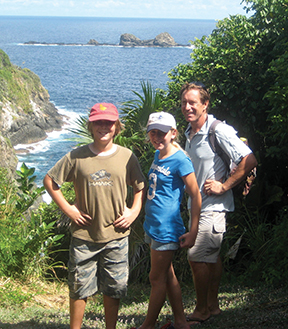
We took a day trip, boarding the local bus (a big one this time) to travel the 20 minutes or so to the other side of the island to visit the village of Speyside. It took just a few minutes to find someone to take us over to Little Tobago Island (we had read of the wonderful bird watching on this uninhabited nature sanctuary). A fair price was soon negotiated (TT$80 to take six of us round trip plus a genial guide). We hiked up and down (it seemed mostly up) this rugged little island and spotted perhaps four birds in total. The scenery was beautiful and we did spot Red Billed Tropic Birds with dramatic long white tails. We expressed our disappointment with the lack of actual birds to our guide, who informed us that in recent years the birds had been scarce. Back on the mainland, we took solace in delicious roti at the snackette across from the school before walking up the road to have cold beer and friendly conversation with some nice folks at the Speyside Inn.
On October 29th, we hightailed it to Grenada, regretfully cutting our visit to Tobago short as Hurricane Tomas bore down on the Windwards. We could have easily spent a couple more weeks enjoying clean, green, serene Tobago, as it proved to be an ideal place to take a break from boat projects and have a vacation!
From Tobago, Elizabeth and family island-hopped back up to St. Lucia, then west to the ABCs. In Bonaire they decided to head for the Galapagos via Columbia, the San Blas Islands and the Panama Canal. Elizabeth and her son returned to Canada from the South Pacific in May 2011 while her husband and daughter spent six months crossing to Australia. The family was reunited at Christmas in New Zealand. Elizabeth now spends her time writing about her travels and working as VP of Business Development and Marketing for MQO Research.















